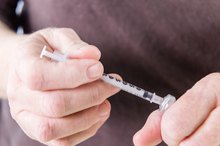How Oral Rehydration Salt Works
Becoming dehydrated can happen to anyone, and in some cases, it can become a medical emergency requiring hospital admission. Until recently, there was no good way to rapidly rehydrate a severly dehydrated person. With the development of oral rehydration salts, effective, rapid rehydration is now possible. These salts work because their formula is based on a sound understanding of gastrointestinal physiology. In contrast to popular belief, sports drinks are not very useful for rehydrating a dangerously dehydrated person.
Dehydration
Dehydration occurs as a result of taking in or losing too much fluid. Vomiting and diarrhea are common causes; so is exercise, in a healthy person. Mild dehydration can cause dizziness and confusion. More severe dehydration can cause lethargy, coma, and death. If you've become severly dehydrated, you may need to go to the hospital for rehydration. In less severe cases, home rehydration works fine. In either case, oral rehydration salts are a good option for rehydration therapy.
About Oral Rehydration Salts
Drinking Salt Water for Adrenal Fatigue
Learn More
Generally speaking, oral rehydration therapy consists of salts and fluids given by mouth to rehydrate a dehydrated person. We take them for granted today, but as recently as 50 years ago, they did not exist. According to UNICEF, the technique behind oral rehydration therapy was developed by Bangladeshi researchers in response to recurrent epidemics of cholera in their country and others in the region; cholera victims died not because of infections, per se, but because they had uncontrollable diarrhea and lost massive quantities of fluid that, prior to the development of oral rehydration therapy, were unable to be effectively replenished.
Salt Absorption
The principle behind oral rehydration therapy is simple enough: When a person has diarrhea, fluid moves through their intestines too quickly to be absorbed in the normal fashion. However, the intestines have on their surface a "sodium-glucose cotransporter," a protein that absorbs salt much better in the presence of glucose. Oral rehydration solutions simply provide the right mix of salt, water and glucose so that salt absorption is maximized, say Stephen and Jennifer Freedman in "Tintinalli's Emergency Medicine."
Osmolarity and Fluid Dynamics
Seizure From Low Sodium Levels
Learn More
Osmolarity is a measurement that describes the concentration of substances in a fluid that are able to exert a force on that fluid. The higher the osmolarity, the more force placed on the fluid, so that if a high osmolarity solution is placed next to a low osmolarity solution, fluid will move from the low to the high osmolarity solution until the two solutions have equal osmolarity. This has practical consequences for fluids absorbed into your bloodstream: If fluids in your intestines are more osmotically active than your blood, they will draw fluid to them, further dehydrating you. Oral rehydration salts work because they are osmotically rather close in composition to your blood; for this reason, when they move into your bloodstream, they stay there, and you are rapidly rehydrated.
Why Sports Drinks Fail in Severe Dehydration
The preceding discussion of transport proteins and fluid dynamics should help you understand why sports drinks — popularly thought of as good rehydration solutions — are not very effective in treating someone with severe dehydration. According to the Freedmans, the balance of sugar to salt in most sports drinks is drastically skewed toward sugar. So when you drink a sports drink, you may absorb some salt, but you also introduce a large quantity of another osmotically-active substance — sugar — which is unabsorbable in the absence of extra salt and which pulls more fluid into your intestines, worsening your dehydration.
Related Articles
References
- "Tintinalli's Emergency Medicine: A Comprehensive Study Guide." Judith E. Tintinalli, J. Stephan Stapczynski, David M. Cline, O. John Ma, Rita K. Cydulka, and Garth D. Meckler; 2004
- NIH: Oral Rehydration Therapy
Resources
Writer Bio
Alex Folkl has been writing for more than eight years and has had work appear in several peer-reviewed and non-peer-reviewed scientific publications. He has a bachelor's degree in biology, a master's degree in pathobiology, and an MD.









